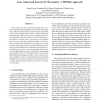Free Online Productivity Tools
i2Speak
i2Symbol
i2OCR
iTex2Img
iWeb2Print
iWeb2Shot
i2Type
iPdf2Split
iPdf2Merge
i2Bopomofo
i2Arabic
i2Style
i2Image
i2PDF
iLatex2Rtf
Sci2ools
ICPR
2004
IEEE
2004
IEEE
Laser Stripe Peak Detector for 3D Scanners. A FIR Filter Approach
The accuracy of a 3D reconstruction using laser scanners is significantly determined by the detection of the laser stripe. Since the energy pattern of such a stripe corresponds to a Gaussian profile, it makes sense to detect the point of maximum light intensity (or peak) by computing the zerocrossing point of the first derivative of such Gaussian profile. However, because noise is present in every physical process, such as electronic image formation, it is not sensitive to perform the derivative of the image of the stripe in almost any situation, unless a previous filtering stage is done. Considering that stripe scanning is an inherently rowparallel process, every row of a given image must be processed independently in order to compute its corresponding peak position in the row. This paper reports on the use of digital filtering techniques in order to cope with the scanning of different surfaces with different optical properties and different noise levels, leading to the proposal of a...
| Added | 09 Nov 2009 |
| Updated | 09 Nov 2009 |
| Type | Conference |
| Year | 2004 |
| Where | ICPR |
| Authors | Carles Pous, Enric Cabruja, Joaquim Salvi, Josep Forest |
Comments (0)

